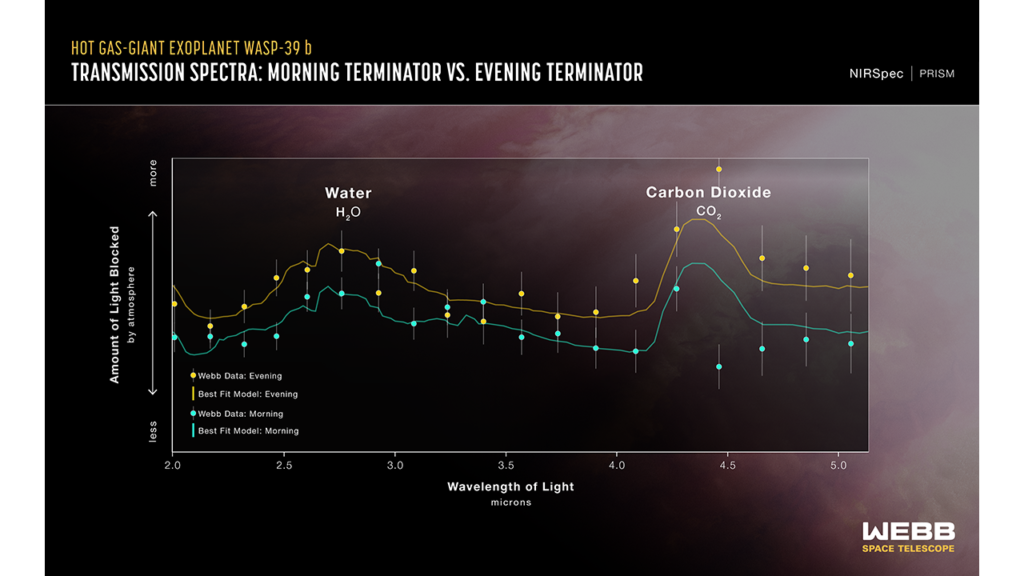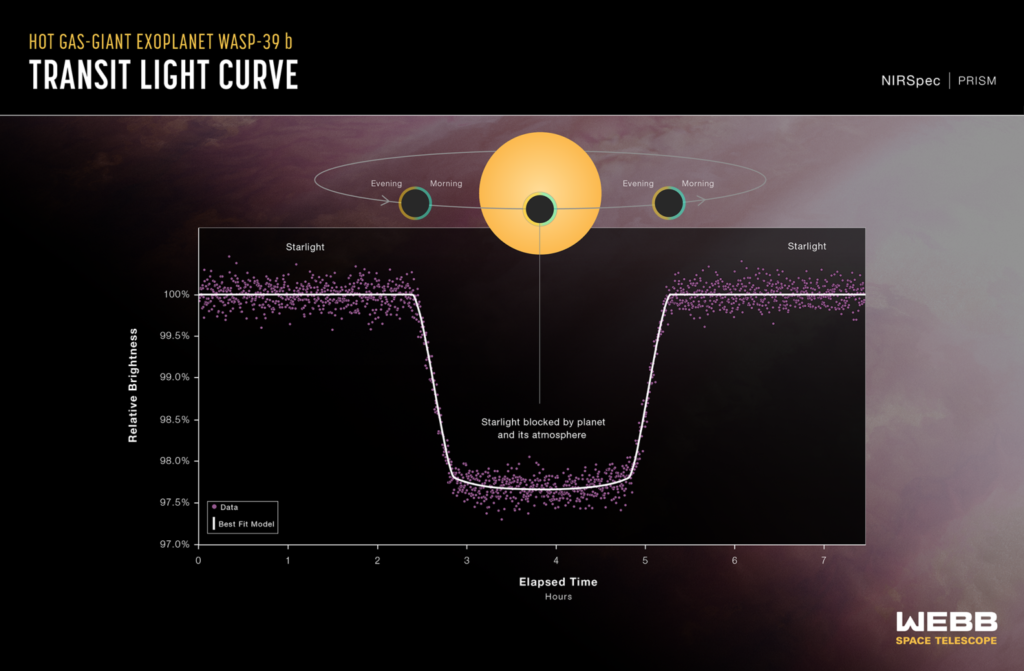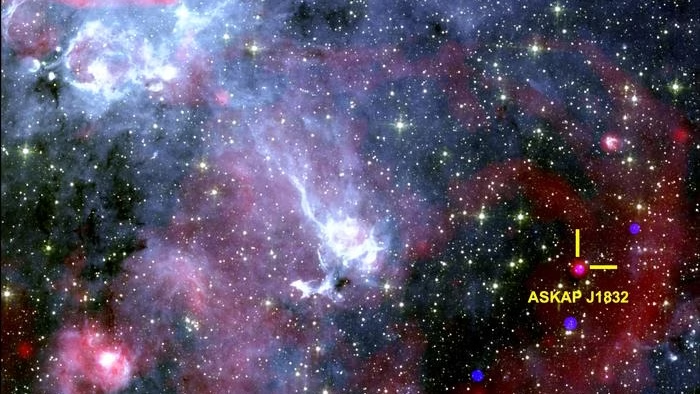Researchers from the Space Telescope Science Institute have used NASA’s James Webb Space Telescope to confirm atmospheric differences on the tidally locked exoplanet WASP-39 b.
From NASA/Goddard Space Flight Center 17/07/24

Researchers using NASA’s James Webb Space Telescope have finally confirmed what models have previously predicted.
An exoplanet has differences between its eternal morning and eternal evening atmosphere.
WASP-39 b, a giant planet with a diameter 1.3 times greater than Jupiter, but similar mass to Saturn that orbits a star about 700 light-years away from Earth, is tidally locked to its parent star.
This means it has a constant dayside and a constant nightside—one side of the planet is always exposed to its star, while the other is always shrouded in darkness.
Using Webb’s NIRSpec (Near-Infrared Spectrograph), astronomers confirmed a temperature difference between the eternal morning and eternal evening on WASP-39 b, with the evening appearing hotter by roughly 300 Fahrenheit degrees (about 200 Celsius degrees).
They also found evidence for different cloud cover, with the forever morning portion of the planet being likely cloudier than the evening.
Astronomers analyzed the 2- to 5-micron transmission spectrum of WASP-39 b, a technique that studies the exoplanet’s terminator, the boundary that separates the planet’s dayside and nightside.
A transmission spectrum is made by comparing starlight filtered through a planet’s atmosphere as it moves in front of the star, to the unfiltered starlight detected when the planet is beside the star.
When making that comparison, researchers can get information about the temperature, composition, and other properties of the planet’s atmosphere.
“WASP-39 b has become a sort of benchmark planet in studying the atmosphere of exoplanets with Webb,” said Néstor Espinoza, an exoplanet researcher at the Space Telescope Science Institute and lead author on the study.
“It has an inflated, puffy atmosphere, so the signal coming from starlight filtered through the planet’s atmosphere is quite strong.”
Previously published Webb spectra of WASP-39b’s atmosphere, which revealed the presence of carbon dioxide, sulfur dioxide, water vapor, and sodium, represent the entire day/night boundary – there was no detailed attempt to differentiate between one side and the other.
Now, the new analysis builds two different spectra from the terminator region, essentially splitting the day/night boundary into two semicircles, one from the evening, and the other from the morning.
Data reveals the evening as significantly hotter, a searing 1,450 degrees Fahrenheit (800 degrees Celsius), and the morning a relatively cooler 1,150 degrees Fahrenheit (600 degrees Celsius).
“It’s really stunning that we are able to parse this small difference out, and it’s only possible due Webb’s sensitivity across near-infrared wavelengths and its extremely stable photometric sensors,” said Espinoza.
“Any tiny movement in the instrument or with the observatory while collecting data would have severely limited our ability to make this detection. It must be extraordinarily precise, and Webb is just that.”
Extensive modeling of the data obtained also allows researchers to investigate the structure of WASP-39 b’s atmosphere, the cloud cover, and why the evening is hotter.
While future work by the team will study how the cloud cover may affect temperature, and vice versa, astronomers confirmed gas circulation around the planet as the main culprit of the temperature difference on WASP-39 b.
On a highly irradiated exoplanet like WASP-39 b that orbits relatively close to its star, researchers generally expect the gas to be moving as the planet rotates around its star.
Hotter gas from the dayside should move through the evening to the nightside via a powerful equatorial jet stream.

Since the temperature difference is so extreme, the air pressure difference would also be significant, which in turn would cause high wind speeds.
Using General Circulation Models, 3-dimensional models similar to the ones used to predict weather patterns on Earth, researchers found that on WASP-39 b the prevailing winds are likely moving from the night side across the morning terminator, around the dayside, across the evening terminator and then around the nightside.
As a result, the morning side of the terminator is cooler than the evening side.
In other words, the morning side gets slammed with winds of air that have been cooled on the nightside, while the evening is hit by winds of air heated on the dayside.
Research suggests the wind speeds on WASP-39 b can reach thousands of miles an hour.
“This analysis is also particularly interesting because you’re getting 3D information on the planet that you weren’t getting before,” added Espinoza.
“Because we can tell that the evening edge is hotter, that means it’s a little puffier. So, theoretically, there is a small swell at the terminator approaching the nightside of the planet.”
The team’s results have been published in Nature.
The researchers will now look to use the same method of analysis to study atmospheric differences of other tidally locked hot Jupiters, as part of Webb Cycle 2 General Observers Program 3969.
WASP-39 b was among the first targets analyzed by Webb as it began regular science operations in 2022.
The data in this study was collected under Early Release Science program 1366, designed to help scientists quickly learn how to use the telescope’s instruments and realize its full science potential.


More info
You may also be curious about:
-

Skin bacteria help protect us from sunlight
-

New brain-reading video game reduces chronic nerve pain
-

Black tea and berries could contribute to healthier aging
-

Viral mouth-taping trend ‘sus’ says Canadian sleep expert
-

New sodium fuel cell could enable electric aviation
-

The most extreme solar storm hit Earth over 14,000 years ago, scientists identify
-

Electronic face tattoo gauges mental strain
-

Solitonic superfluorescence paves way for ambient temp quantum computing
-

Cosmic mystery deepens as astronomers find object flashing in both radio waves and X-rays
-

The rotors are also the wheels on this morphobot
-

Bed bugs are most likely the first human pest, 60,000 years and counting
-

What lurks beneath? Only 0.001 percent of the deep seafloor has been imaged
